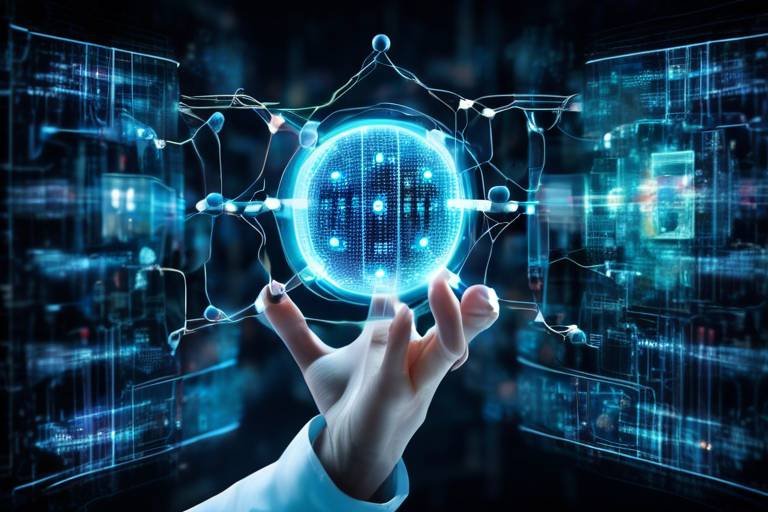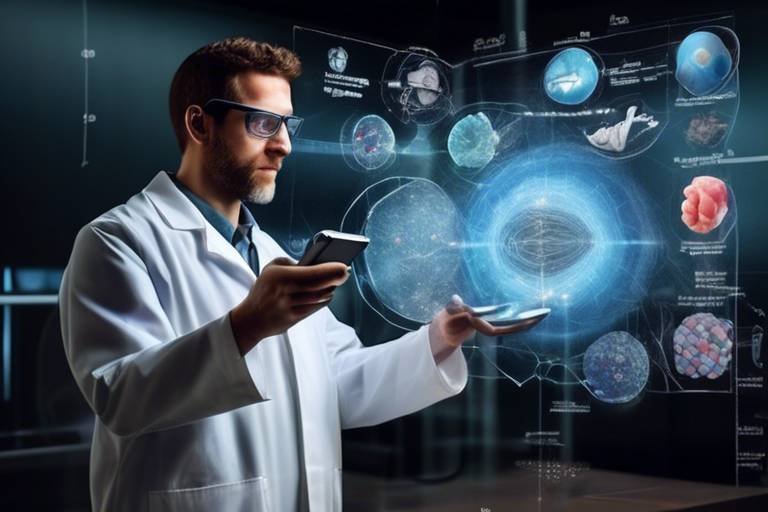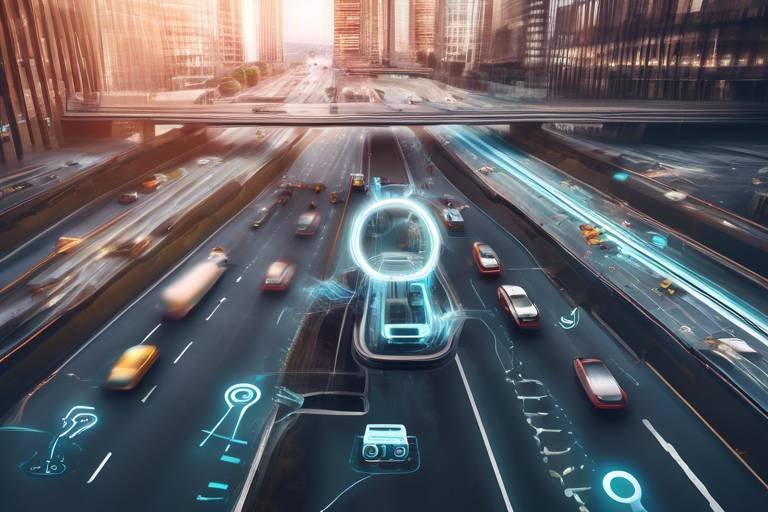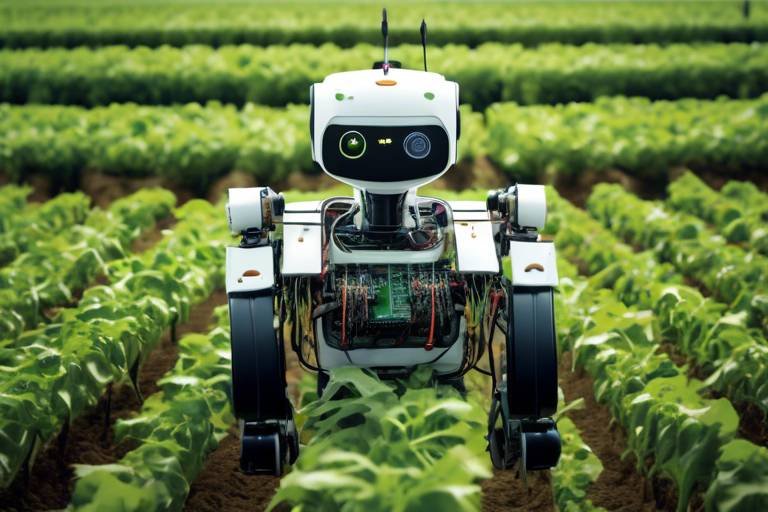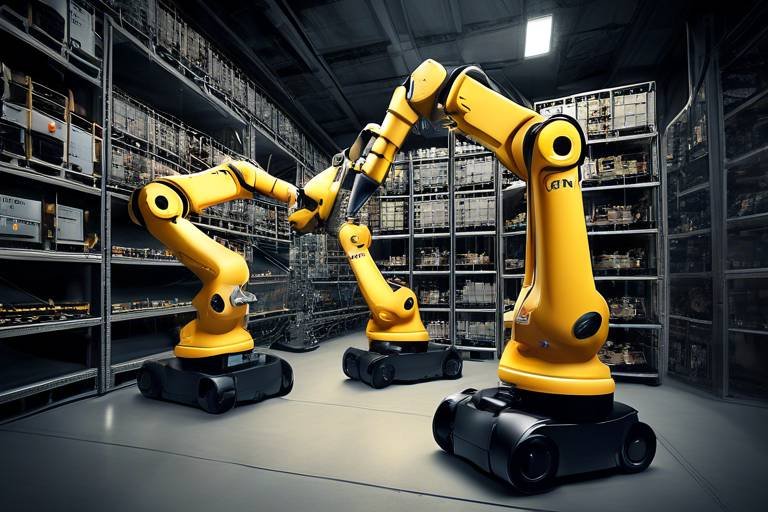The Science of Cyber-Physical Systems in Research
In today’s fast-paced technological landscape, the intersection of the digital and physical worlds is becoming increasingly significant. This is where Cyber-Physical Systems (CPS) come into play. Imagine a world where machines not only perform tasks but also communicate with one another and adapt based on real-time data from their environments. This article explores the intricate relationship between CPS and their applications in research, highlighting their significance, challenges, and future directions in various domains.
Cyber-Physical Systems are essentially a blend of computation, networking, and physical processes. They integrate software and hardware components to create systems that can monitor and control physical entities. Think of CPS as the nervous system of a smart city, where sensors gather data, algorithms process that information, and actuators respond to changes in the environment. The fundamental components of CPS include:
- Sensors: Devices that collect data from the physical world.
- Actuators: Components that perform actions based on the processed data.
- Communication Networks: Channels that facilitate data exchange between components.
- Control Algorithms: Software that interprets data and makes decisions.
This integration enables CPS to operate in real-world environments, making them essential for applications ranging from smart homes to industrial automation.
CPS are transforming research across multiple fields by enhancing the way data is collected, analyzed, and utilized. Their applications are vast and varied, and they are driving innovation and efficiency in areas such as:
- Healthcare
- Transportation
- Environmental Monitoring
By leveraging CPS, researchers can gather real-time data, leading to more informed decisions and improved outcomes.
In the realm of healthcare, Cyber-Physical Systems are revolutionizing patient monitoring and treatment. They enable healthcare professionals to track patients remotely, ensuring timely interventions and personalized care. Two prominent applications include:
Telemedicine leverages CPS to provide remote healthcare services, allowing patients to consult with doctors without the need for physical visits. This innovation is particularly beneficial in rural areas where access to healthcare facilities is limited. Technologies such as video conferencing, remote monitoring devices, and mobile health applications are at the forefront of this transformation. These tools not only enhance patient access but also improve the overall quality of care.
Wearable devices equipped with CPS capabilities are changing the way individuals manage their health. From fitness trackers to smartwatches, these devices continuously monitor health metrics like heart rate, activity levels, and sleep patterns. They empower users to take charge of their health, enabling data-driven decisions and preventative care. Imagine having a personal health assistant on your wrist, guiding you toward a healthier lifestyle!
The transportation sector also reaps significant benefits from CPS integration. With advancements in autonomous vehicles and smart traffic management systems, the potential for enhanced safety and efficiency is enormous. Picture a world where vehicles communicate with each other to prevent accidents, or traffic lights adjust in real-time to optimize traffic flow. These innovations not only reduce congestion but also lower emissions, contributing to a more sustainable future.
Despite their numerous advantages, implementing Cyber-Physical Systems comes with its own set of challenges. Key issues include security vulnerabilities, interoperability, and the need for robust data management strategies. Understanding these challenges is crucial for the successful deployment of CPS.
Security is a critical concern for CPS. With the interconnected nature of these systems, potential threats and vulnerabilities can compromise system integrity. Imagine a scenario where a hacker gains access to a smart healthcare system, endangering patient safety. This emphasizes the need for comprehensive cybersecurity measures to protect sensitive data and ensure reliable system operation.
Interoperability among different CPS components is essential for seamless operation. However, integrating diverse systems and standards presents significant challenges. For example, consider a smart city where various devices from different manufacturers need to work together. Establishing common protocols and standards is crucial to overcoming these barriers and ensuring effective communication between systems.
1. What are Cyber-Physical Systems?
Cyber-Physical Systems are integrations of computation, networking, and physical processes that enable systems to monitor and control physical entities.
2. How are CPS used in healthcare?
CPS are used in healthcare for remote patient monitoring, telemedicine services, and smart wearable devices that track health metrics.
3. What challenges do CPS face?
CPS face challenges such as security vulnerabilities, interoperability issues, and the need for effective data management strategies.
4. How do CPS improve transportation systems?
CPS improve transportation through advancements in autonomous vehicles and smart traffic management, enhancing safety and efficiency.

[Understanding Cyber-Physical Systems]
Cyber-physical systems (CPS) represent a revolutionary blend of computation and physical processes, creating a synergy that enhances the way we interact with the world around us. Imagine a world where the digital realm seamlessly integrates with the physical one, where machines not only process data but also interact with their environment in real-time. This is the essence of CPS. These systems consist of a network of sensors, actuators, and computational units that work together to monitor and control physical processes. From smart homes to advanced manufacturing, the applications are vast and varied.
At the core of CPS lies a few fundamental components:
- Sensors: These devices collect data from the physical environment, such as temperature, motion, or pressure, and transmit it to the computational units.
- Actuators: These are the mechanisms that perform actions based on the commands from the computational units, influencing the physical processes.
- Computational Units: These units process the data received from sensors, make decisions, and send commands to actuators to carry out specific tasks.
The fundamental principles governing CPS operation can be likened to the way a conductor leads an orchestra. Just as a conductor coordinates various instruments to create harmonious music, CPS coordinates its components to achieve optimal functionality. This orchestration allows for real-time data processing and decision-making, which is crucial in scenarios where immediate responses are necessary, such as in autonomous vehicles or industrial automation.
Moreover, CPS operates on a feedback loop. The sensors gather data, the computational units analyze this data, and the actuators execute actions based on the analysis. This continuous cycle not only enhances efficiency but also allows for adaptive learning, where the system can improve its performance over time based on past experiences. However, this complexity also introduces challenges, particularly in terms of system design and integration.
As we delve deeper into the world of CPS, it becomes clear that these systems are not just technological marvels; they are the backbone of modern innovation. They enable smarter cities, more efficient healthcare solutions, and advanced manufacturing processes. Understanding CPS is not merely about grasping their technical aspects; it's about recognizing their potential to transform our lives and the world we inhabit.

[Applications of CPS in Research]
Cyber-physical systems (CPS) are not just a buzzword; they are revolutionizing the way research is conducted across various domains. Imagine a world where physical and digital realms interact seamlessly, enhancing our understanding and capabilities. This is precisely what CPS offers. From healthcare to transportation, CPS is making waves by improving efficiency, accuracy, and innovation. Let’s dive deeper into how these systems are applied in different fields and the profound impact they have.
In the realm of healthcare, CPS has emerged as a game-changer. Think about the traditional patient monitoring systems that often required physical presence. Now, with CPS, we can monitor patients remotely, ensuring that they receive timely care without the need to visit a hospital. This shift not only saves time but also enhances the quality of care. For instance, telemedicine platforms utilize CPS technologies to connect patients with healthcare providers in real-time, enabling consultations that are as effective as in-person visits. This is a significant leap towards making healthcare more accessible, especially for those in remote areas.
Moreover, the rise of smart wearable devices has further transformed patient care. These devices, embedded with CPS capabilities, allow users to track vital health metrics such as heart rate, blood pressure, and even glucose levels. Imagine wearing a device that not only tracks your fitness but also alerts your doctor in case of any anomalies. This proactive approach to health management is paving the way for preventative care and personalized medicine, where treatments can be tailored to individual needs based on real-time data.
Moving on to transportation, CPS integration is enhancing safety and efficiency in ways we never thought possible. Picture autonomous vehicles that can communicate with each other and with traffic management systems. These vehicles utilize CPS to analyze real-time traffic data, adjust routes, and reduce congestion. The result? A safer, more efficient transportation system that minimizes human error and optimizes travel time. Furthermore, smart traffic management systems can adapt to changing conditions, ensuring that traffic flows smoothly and reducing the likelihood of accidents.
Another area where CPS is making a significant impact is in environmental monitoring. With the help of CPS, researchers can collect and analyze data from various sources, such as weather stations, pollution sensors, and satellite imagery. This data can be used to monitor climate change, track wildlife populations, and even predict natural disasters. By integrating physical and computational processes, CPS provides researchers with the tools they need to make informed decisions and develop strategies for sustainable living.
To sum it up, the applications of cyber-physical systems in research are vast and varied. As we continue to explore the potential of CPS, we unlock new possibilities that can lead to groundbreaking innovations. Whether it’s enhancing healthcare delivery, improving transportation safety, or monitoring environmental changes, CPS is at the forefront of research advancements. The future is bright, and the integration of CPS into various fields is just the beginning of a transformative journey.
- What are cyber-physical systems?
CPS are integrations of computation with physical processes, allowing for real-time monitoring and control of physical systems.
- How do CPS improve healthcare?
They enhance patient monitoring through telemedicine and smart wearables, providing timely and personalized care.
- What role do CPS play in transportation?
CPS enable autonomous vehicles and smart traffic management, improving safety and efficiency in transportation systems.
- Can CPS help with environmental issues?
Yes, CPS facilitate better data collection and analysis for monitoring climate change and managing natural resources.

[CPS in Healthcare]
In today's fast-paced world, the integration of Cyber-Physical Systems (CPS) in healthcare is not just a trend; it's a revolutionary shift that enhances patient monitoring and treatment methodologies. Imagine a world where your health metrics are constantly monitored, and immediate feedback is provided to both you and your healthcare provider. This is not science fiction; it's the reality brought about by CPS. These systems seamlessly connect physical health processes with computational intelligence, creating a more responsive healthcare environment.
One of the most significant applications of CPS in healthcare is through telemedicine. Telemedicine leverages advanced technologies to deliver healthcare services remotely, breaking down geographical barriers and making healthcare accessible to everyone. For instance, a patient in a rural area can consult with a specialist located hundreds of miles away through video conferencing, all while their vital signs are monitored in real-time via connected devices. This not only saves time but also significantly reduces the cost of healthcare delivery.
Another exciting development in this realm is the rise of smart wearable devices. These gadgets, ranging from smartwatches to advanced fitness trackers, are equipped with CPS capabilities that allow them to monitor various health metrics, such as heart rate, blood pressure, and even glucose levels. The data collected by these devices can be transmitted to healthcare providers, enabling a proactive approach to health management. For example, if a patient's heart rate spikes unexpectedly, the device can alert both the patient and their doctor, allowing for timely intervention.
The importance of these technologies cannot be overstated. They play a crucial role in preventative care and personalized medicine. By continuously collecting and analyzing data, healthcare providers can tailor treatment plans to individual needs, leading to better outcomes. Patients become active participants in their health journey, empowered by information and insights that were previously unavailable.
To illustrate the impact of CPS in healthcare, consider the following table that highlights some key innovations:
| Innovation | Description | Impact |
|---|---|---|
| Telemedicine | Remote consultations and monitoring | Increased access to healthcare services |
| Smart Wearables | Devices tracking health metrics | Enhanced preventative care and personalized treatment |
| Remote Patient Monitoring | Continuous monitoring of patients' health | Timely interventions and reduced hospital visits |
As we move forward, the potential for CPS in healthcare is boundless. With ongoing advancements in technology, we can expect even more innovative solutions that will transform the way we approach health and wellness. The future is bright, and it’s all about harnessing the power of cyber-physical systems to create a healthier world for everyone.
Frequently Asked Questions
- What are Cyber-Physical Systems?
Cyber-Physical Systems are integrations of computation with physical processes, enabling real-time monitoring and control. - How does telemedicine work?
Telemedicine uses technology to provide remote healthcare services, allowing patients to consult with doctors via video calls and other digital platforms. - What are smart wearables?
Smart wearables are devices like fitness trackers and smartwatches that monitor health metrics and provide data to users and healthcare providers.

[Telemedicine Innovations]
Telemedicine has emerged as a groundbreaking application of cyber-physical systems (CPS), fundamentally altering the landscape of healthcare. By integrating advanced technology with healthcare services, telemedicine offers a plethora of benefits that enhance patient care and streamline medical processes. Imagine a world where you can consult a doctor from the comfort of your home, without the need to travel to a clinic. This is no longer a futuristic dream; it's a reality made possible by CPS innovations.
One of the most significant advancements in telemedicine is the ability to conduct real-time patient monitoring. Using smart devices equipped with sensors, healthcare providers can continuously track vital signs such as heart rate, blood pressure, and oxygen levels. This data is transmitted seamlessly to medical professionals, allowing for immediate intervention if any abnormalities are detected. For instance, a patient with a chronic condition can be monitored from home, reducing the need for frequent hospital visits and providing peace of mind for both the patient and their family.
Additionally, telemedicine platforms are leveraging artificial intelligence (AI) and machine learning to enhance diagnostic accuracy. By analyzing vast amounts of data, these systems can identify patterns that may not be obvious to human practitioners. This leads to quicker diagnoses and more personalized treatment plans. For example, AI algorithms can analyze a patient's history and symptoms to suggest potential conditions, prompting timely consultations with specialists.
Moreover, telemedicine is bridging the gap between patients and healthcare providers, particularly in rural or underserved areas. With limited access to healthcare facilities, individuals in these regions often face significant barriers to receiving care. Telemedicine eliminates these obstacles by enabling virtual consultations, ensuring that everyone, regardless of their location, has access to quality healthcare. This is especially crucial during public health crises, such as the COVID-19 pandemic, where minimizing physical contact became essential.
To illustrate the impact of telemedicine innovations, consider the following table that highlights key benefits:
| Benefit | Description |
|---|---|
| Increased Accessibility | Patients can receive care from anywhere, reducing travel time and costs. |
| Enhanced Monitoring | Real-time data collection allows for proactive healthcare management. |
| Cost-Effectiveness | Reduces the overall cost of healthcare by minimizing hospital visits. |
| Improved Patient Engagement | Patients are more involved in their healthcare decisions through accessible information. |
In summary, the innovations in telemedicine powered by cyber-physical systems are not just transforming healthcare; they are redefining it. As technology continues to evolve, we can expect even more exciting developments in this field, making healthcare more accessible, efficient, and personalized than ever before. The future of telemedicine is bright, and it promises to be a game-changer for patients and providers alike.
- What is telemedicine? Telemedicine refers to the use of telecommunications technology to provide medical care remotely.
- How does telemedicine improve patient care? It allows for real-time monitoring, quicker diagnoses, and easier access to healthcare services.
- Are telemedicine consultations secure? Yes, most telemedicine platforms use encryption and other security measures to protect patient data.
- Can telemedicine replace in-person visits? While it can handle many situations, some cases still require physical examinations.

[Smart Wearable Devices]
In the rapidly evolving landscape of healthcare, smart wearable devices have emerged as game-changers, revolutionizing how we monitor and manage our health. These devices, which include smartwatches, fitness trackers, and even advanced medical wearables, harness the power of cyber-physical systems (CPS) to collect, analyze, and transmit health data in real-time. Imagine having a personal health assistant on your wrist, constantly tracking your heart rate, sleep patterns, and activity levels, all while providing you with actionable insights. This level of monitoring not only empowers individuals to take charge of their health but also enables healthcare providers to deliver more personalized care.
One of the most significant advantages of smart wearables is their ability to facilitate preventative care. By continuously gathering data, these devices can detect anomalies or trends that might indicate health issues before they escalate into serious problems. For instance, a smartwatch that monitors your heart rate can alert you to irregularities, prompting you to seek medical advice before a potential cardiac event occurs. This proactive approach not only enhances patient outcomes but also reduces the burden on healthcare systems.
Moreover, smart wearables are increasingly being integrated into chronic disease management. Patients with conditions such as diabetes or hypertension can benefit immensely from these devices. For example, continuous glucose monitors (CGMs) provide real-time data on blood sugar levels, allowing patients to adjust their insulin doses promptly. This integration of technology into daily health management can significantly improve the quality of life for individuals living with chronic conditions.
Furthermore, the data collected by smart wearables can be invaluable for research and development in the healthcare sector. Researchers can analyze aggregated data from thousands of users to identify trends, assess the effectiveness of treatments, and develop new health interventions. This data-driven approach not only accelerates the pace of innovation but also ensures that healthcare solutions are tailored to meet the diverse needs of the population.
However, it’s essential to consider the privacy and security implications of these devices. As they collect sensitive health information, ensuring that this data is protected from unauthorized access is paramount. Manufacturers and developers must implement robust security measures to safeguard users' data, fostering trust in these technologies. After all, what good is a smart device if users are concerned about the safety of their personal information?
In summary, smart wearable devices represent a significant leap forward in healthcare technology. Their ability to provide real-time health monitoring, enhance preventative care, and facilitate chronic disease management makes them indispensable tools in the modern healthcare toolkit. As technology continues to advance, we can expect these devices to become even more sophisticated, offering new features and capabilities that will further improve patient outcomes and healthcare delivery.
- What types of smart wearable devices are available? Smart wearables include smartwatches, fitness trackers, smart clothing, and medical-grade devices like continuous glucose monitors.
- How do smart wearables improve healthcare? They provide real-time health monitoring, facilitate early detection of health issues, and enable personalized care through data analysis.
- Are smart wearables secure? While they offer many benefits, security varies by device; it's essential to choose products from reputable manufacturers that prioritize data protection.
- Can smart wearables replace traditional medical devices? While they can complement traditional devices, they are not a complete replacement, especially in critical medical situations.

[CPS in Transportation]
Transportation systems are undergoing a revolutionary transformation thanks to the integration of cyber-physical systems (CPS). Imagine a world where vehicles communicate with each other and with traffic signals in real-time, optimizing traffic flow and enhancing safety. This is not just a futuristic dream; it’s happening right now! CPS in transportation encompasses a variety of technologies, including autonomous vehicles, smart traffic management systems, and intelligent transportation networks that significantly improve the efficiency and safety of our roads.
One of the most exciting applications of CPS in transportation is the development of autonomous vehicles. These vehicles utilize advanced sensors, machine learning algorithms, and real-time data processing to navigate complex environments without human intervention. For instance, companies like Tesla and Waymo are pioneering this technology, enabling cars to make decisions based on their surroundings, such as detecting pedestrians or adjusting speed according to traffic conditions. The potential benefits are enormous:
- Reduced accidents: With fewer human errors, the risk of collisions is significantly decreased.
- Improved traffic flow: Autonomous vehicles can communicate with each other to maintain optimal distances and speeds.
- Environmental benefits: Enhanced efficiency can lead to reduced fuel consumption and lower emissions.
Moreover, CPS enhances traditional traffic management systems. Smart traffic lights equipped with sensors can adjust their timing based on real-time traffic conditions, reducing congestion and improving travel times. This technology not only makes our commutes quicker but also contributes to lowering pollution levels in urban areas. For example, cities like Los Angeles and Singapore are implementing these smart systems, resulting in significant improvements in traffic efficiency.
Furthermore, the integration of CPS in public transportation systems is another area ripe for innovation. Buses and trains equipped with real-time tracking and communication capabilities can provide passengers with accurate arrival times and optimize routes based on current demand. This not only enhances the user experience but also encourages more people to utilize public transport, thereby reducing the number of vehicles on the road.
However, the journey to fully realize the potential of CPS in transportation is not without its challenges. Issues such as security vulnerabilities and the need for robust data management strategies must be addressed. As we increasingly rely on interconnected systems, the risk of cyberattacks becomes a pressing concern. Ensuring the integrity and security of these systems is paramount to gaining public trust and achieving widespread adoption.
In summary, the integration of cyber-physical systems in transportation is paving the way for smarter, safer, and more efficient travel. As technology continues to evolve, we can expect even more innovative solutions that will reshape the way we move and interact in our daily lives. The future of transportation is not just about getting from point A to point B; it's about creating an interconnected ecosystem that enhances our overall quality of life.
Q: What are cyber-physical systems?
A: Cyber-physical systems are integrations of computation with physical processes, allowing for real-time monitoring and control of physical systems.
Q: How do CPS improve transportation safety?
A: CPS enhance transportation safety by enabling vehicles to communicate with each other and with infrastructure, reducing human errors and optimizing traffic flow.
Q: What are some examples of CPS in transportation?
A: Examples include autonomous vehicles, smart traffic management systems, and real-time public transportation tracking.
Q: What challenges do CPS face in transportation?
A: Challenges include security vulnerabilities, interoperability among various systems, and the need for effective data management strategies.

[Challenges in Implementing CPS]
As we dive deeper into the world of Cyber-Physical Systems (CPS), it's essential to recognize that the journey is not without its hurdles. While the potential of CPS to revolutionize various sectors is immense, several challenges impede their seamless implementation. One of the most pressing issues is the security vulnerabilities that these systems face. With the integration of physical and digital components, the attack surface increases, making it easier for malicious actors to exploit weaknesses. Imagine a connected car that can be hacked; the implications for safety are staggering. Therefore, robust cybersecurity measures become a non-negotiable requirement in the development and deployment of CPS.
Another significant challenge is interoperability. CPS often consist of various components from different manufacturers, each with its own protocols and standards. This diversity can lead to compatibility issues, where systems fail to communicate effectively with one another. For example, a smart traffic management system might struggle to integrate with existing infrastructure due to differing communication standards. To address this, the industry must focus on developing common frameworks and standards that facilitate seamless interaction among diverse systems. A collaborative approach involving stakeholders from various sectors can pave the way for a more integrated CPS ecosystem.
Moreover, data management strategies must be meticulously crafted. CPS generate vast amounts of data, and without proper management, this data can become overwhelming. Researchers and practitioners need to establish effective methods for data collection, storage, and analysis. This includes ensuring that data is not only secure but also accessible and usable for decision-making processes. Think of it as trying to find a needle in a haystack; without the right tools and strategies, valuable insights can easily be lost in the noise.
Lastly, the regulatory landscape surrounding CPS is still evolving. Governments and regulatory bodies are grappling with how to create frameworks that protect users while fostering innovation. This often leads to a patchwork of regulations that can stifle progress. Stakeholders must engage in ongoing dialogues with policymakers to shape regulations that are both supportive of technological advancement and protective of public interests.
In summary, while the challenges of implementing CPS are significant, they are not insurmountable. By addressing security, interoperability, data management, and regulatory issues head-on, we can unlock the full potential of these transformative systems. The future of CPS depends on our ability to navigate these challenges effectively and collaboratively.
- What are Cyber-Physical Systems?
CPS integrate computation with physical processes, enabling real-time monitoring and control of physical systems. - What are the main challenges in implementing CPS?
The main challenges include security vulnerabilities, interoperability issues, data management, and evolving regulatory frameworks. - How can security issues in CPS be addressed?
Implementing robust cybersecurity measures, regular system updates, and conducting vulnerability assessments can help mitigate security risks. - Why is interoperability important in CPS?
Interoperability ensures that different CPS components can communicate effectively, leading to more efficient and integrated systems. - What role do regulations play in CPS?
Regulations help protect users and ensure safety while fostering innovation, but they need to be adaptable to keep pace with technological advancements.

[Security Concerns]
In the rapidly evolving landscape of cyber-physical systems (CPS), security stands out as a paramount concern that cannot be overlooked. As CPS increasingly integrate with critical infrastructures such as healthcare, transportation, and energy management, they also become prime targets for malicious attacks. Imagine a world where your smart home is hacked, allowing intruders to manipulate your security systems or even control your appliances. The stakes are high, and the implications can be dire.
One of the most pressing issues in CPS security is the potential for data breaches. Sensitive information, such as personal health data or transportation logistics, can be exposed if adequate security measures are not in place. This can lead not only to financial losses but also to a significant erosion of trust between users and service providers. In fact, a recent study indicated that over 60% of organizations experienced a security incident related to their CPS in the past year. This statistic highlights the critical need for robust cybersecurity protocols.
Moreover, the interconnected nature of CPS introduces a whole new level of complexity when it comes to security. With multiple devices and systems communicating with each other, a vulnerability in one component can potentially compromise the entire network. For instance, if an autonomous vehicle's software is hacked, it could lead to disastrous consequences, not just for the vehicle itself but for all other vehicles and pedestrians in its vicinity. This interconnectedness necessitates a comprehensive approach to security that encompasses all aspects of the system.
To mitigate these risks, organizations must adopt a multi-layered security strategy that includes:
- Regular Security Audits: Conducting frequent assessments to identify and rectify vulnerabilities.
- Data Encryption: Ensuring that sensitive data is encrypted both in transit and at rest to prevent unauthorized access.
- Access Control Mechanisms: Implementing strict access controls to limit who can interact with various components of the system.
- Continuous Monitoring: Utilizing real-time monitoring tools to detect suspicious activities and respond swiftly.
Furthermore, collaboration among stakeholders is essential. Researchers, developers, and policymakers must work together to establish industry standards and best practices for CPS security. By fostering an environment of cooperation, we can enhance the resilience of these systems against potential threats.
In conclusion, while the benefits of cyber-physical systems are immense, the associated security concerns must be addressed proactively. As we continue to integrate CPS into our daily lives, ensuring their security will be crucial in maintaining public safety and trust. The future of CPS hinges not just on their technological advancements but also on our ability to safeguard them against emerging threats.
- What are cyber-physical systems? Cyber-physical systems are integrations of computation with physical processes, enabling real-time monitoring and control of physical systems.
- Why is security a concern for CPS? Due to their interconnected nature, vulnerabilities in one component can compromise the entire system, leading to data breaches and safety issues.
- How can organizations enhance CPS security? By implementing regular audits, data encryption, access controls, and continuous monitoring, organizations can significantly improve their security posture.
- What role do stakeholders play in CPS security? Collaboration among researchers, developers, and policymakers is essential for establishing industry standards and ensuring comprehensive security measures.

[Interoperability Issues]
Interoperability is a cornerstone for the success of cyber-physical systems (CPS). Imagine trying to piece together a jigsaw puzzle where the pieces come from different boxes; that’s what integrating various CPS components can feel like. The challenge lies in ensuring that these systems, often developed by different manufacturers and using diverse communication protocols, can work together seamlessly. In a world where data flows like water and systems are expected to respond in real-time, the lack of interoperability can lead to significant inefficiencies and even catastrophic failures.
One of the major hurdles in achieving interoperability is the diversity of standards and protocols used across different domains. For instance, consider the healthcare sector, where devices from various manufacturers may use different data formats and communication protocols. This fragmentation makes it difficult for systems to share information effectively. A patient’s health data collected by a smart wearable might not be compatible with the hospital's electronic health records (EHR) system, leading to gaps in care. To illustrate this, here’s a simple table that highlights some common interoperability challenges in CPS:
| Challenge | Description |
|---|---|
| Standardization | Absence of universal standards for data formats and communication protocols. |
| Compatibility | Diverse systems may not support each other’s data exchange requirements. |
| Scalability | Difficulty in scaling systems while maintaining interoperability. |
| Security | Interconnected systems can introduce vulnerabilities that compromise data integrity. |
To overcome these challenges, a collaborative approach is essential. Stakeholders must engage in developing common standards that promote compatibility across systems. This means not only technical teams but also policymakers and industry leaders need to come together. Additionally, adopting middleware solutions that can translate between different protocols can facilitate smoother interactions among diverse systems. Think of middleware as a universal translator in a world full of different languages; it breaks down barriers and enables communication.
Furthermore, continuous testing and validation of interoperability should be a priority throughout the development lifecycle of CPS. By integrating interoperability checks early in the design process, developers can identify potential issues before they escalate into significant problems. This proactive approach not only enhances system reliability but also fosters innovation as systems become more adaptable and responsive to changing needs.
In conclusion, while interoperability issues present significant challenges for the successful implementation of cyber-physical systems, they are not insurmountable. With concerted efforts towards standardization, collaboration, and proactive testing, the potential for CPS to revolutionize industries can be fully realized. The future of CPS hinges on our ability to ensure that these systems can communicate effectively, paving the way for smarter, more efficient solutions that enhance our daily lives.
- What are cyber-physical systems?
CPS are integrations of computation with physical processes, enabling real-time monitoring and control of physical systems.
- Why is interoperability important in CPS?
Interoperability allows different systems to work together seamlessly, enhancing efficiency and effectiveness in various applications.
- What are some common challenges in achieving interoperability?
Challenges include standardization issues, compatibility problems, scalability concerns, and security vulnerabilities.
- How can interoperability challenges be addressed?
By developing common standards, using middleware solutions, and implementing continuous testing during the development process.
Frequently Asked Questions
- What are Cyber-Physical Systems (CPS)?
Cyber-Physical Systems (CPS) are integrations of computation with physical processes. They combine hardware and software to create systems that can monitor and control physical environments in real-time, making them essential in various applications, from healthcare to transportation.
- How are CPS used in healthcare?
CPS play a transformative role in healthcare by enabling technologies like telemedicine and smart wearable devices. These applications enhance patient monitoring, facilitate remote consultations, and improve overall healthcare delivery, leading to better patient outcomes.
- What is telemedicine, and how does it relate to CPS?
Telemedicine utilizes CPS to provide remote healthcare services. It leverages technology to allow healthcare providers to monitor patients in real-time, conduct virtual consultations, and manage treatments from a distance, thus revolutionizing access to medical care.
- What are smart wearable devices?
Smart wearable devices equipped with CPS capabilities track various health metrics, such as heart rate and activity levels. They are crucial for preventative care and personalized medicine, enabling users to manage their health proactively based on real-time data.
- How do CPS enhance transportation systems?
CPS significantly improve transportation through advancements such as autonomous vehicles and smart traffic management systems. These technologies work together to enhance safety, reduce traffic congestion, and optimize overall transportation efficiency.
- What challenges are associated with implementing CPS?
Implementing CPS comes with challenges, including security vulnerabilities, interoperability issues, and the need for robust data management strategies. Addressing these concerns is crucial for ensuring the reliability and safety of CPS in various applications.
- What are the security concerns related to CPS?
Security is a major concern for CPS, as these systems can be vulnerable to various threats that may compromise their integrity. Comprehensive cybersecurity measures are essential to protect against potential attacks and ensure the safety of data and operations.
- Why is interoperability important in CPS?
Interoperability among different CPS components is vital for seamless operation. It ensures that diverse systems and standards can work together effectively, which is essential for maximizing the potential of CPS across various applications and industries.

